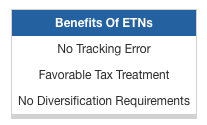Those aren't the only instances of an ETN having significant appeal as a superior investment vehicle. This structure also might make sense for those considering a merger arbitrage strategy, where high portfolio turnover is common. ETFs can have a tendency to incur short-term capital gains on positions held for less than a year, while ETNs can provide a loophole to avoid this potentially unfavorable tax treatment since there are no underlying holdings.

Bottom Line: ETNs feature unique nuances and risks, although this product structure does offer noteworthy advantages over ETFs when accessing certain asset classes, including commodities and MLPs.
98. Currency Carry ETFs Offer Cheap, Liquid Access
One recurring theme throughout the last several years has been the "democratization" of investing that ETFs have advanced. The combination of popular investment styles and strategies with the exchange-traded wrapper has given investors tools to achieve low maintenance, low cost exposure to techniques that previously would have potentially required significant time and money to achieve. A good example of an old strategy recently captured in ETF form is currency carry, a trade that involves borrowing in low-yielding currencies and investing the proceeds in high-yielding currencies. If there are no huge swings in exchange rates, the result can be a steady profit with minimal risk. There are a couple ETPs out there that deliver cheap, liquid access to this tried and true technique:
Optimized Currency Carry ETN (ICI)
DB G10 Currency Harvest (DBV)
It should be noted that these products are far from identical; the currencies that comprise both long and short positions often vary quite a bit.
Bottom Line: Some of the more advanced currency ETFs offer compelling strategies that are otherwise too costly and complex for most investors to implement on their own.
99. Bond Sector ETFs: Balance Out Fixed Income Exposure
ETFs that focus on specific sectors of U.S. and international stock markets have been around for years, and in many cases there are a number of options all offering generally similar exposure. But on the fixed income side of the equation, sector-specific granularity has been a more recent development. Just as significant tilts towards a certain type of stock can be less than optimal, concentrations in bond portfolios can result in unnecessary risks.








